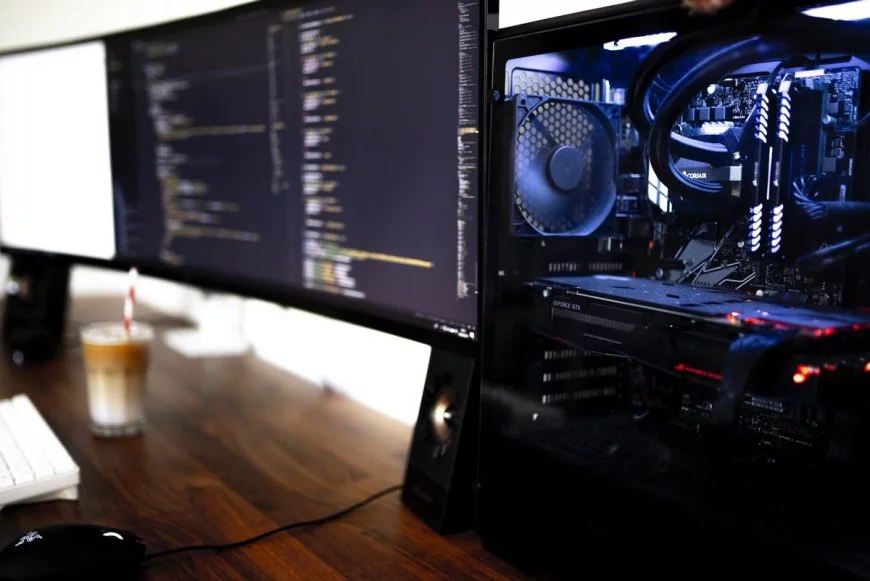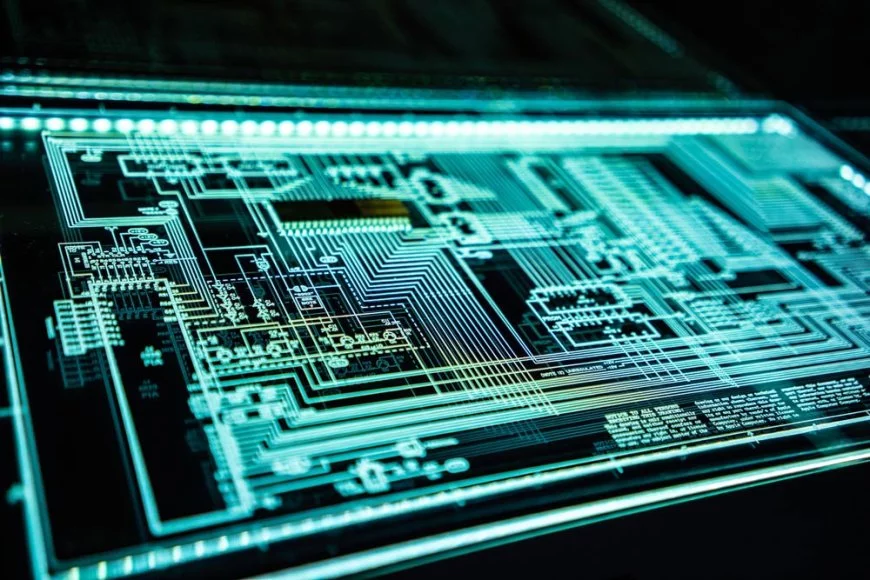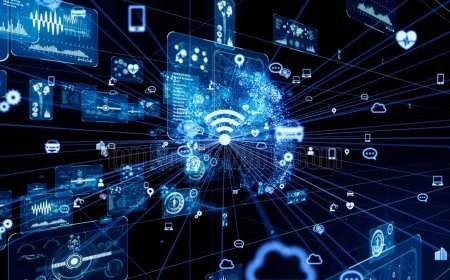Why Edge Computing Is an Extension of cloud computing?
Discover the benefits and use cases of edge computing, an extension of cloud computing that brings compute resources closer to the data source, in our latest blog post.

Edge computing refers to the practice of processing and analyzing data at the edge of the network, closer to the source of the data, rather than at a centralized location. This approach enables faster response times, reduced bandwidth usage, and improved security, making it increasingly relevant in today's world.
As the Internet of Things (IoT) continues to grow and result in vast amounts of data being generated, traditional cloud computing and centralized data processing solutions are becoming increasingly inefficient. Edge computing provides a decentralized approach to data processing, enabling IoT devices and other endpoints to perform local computations and make decisions in real time.
Another key driver of the adoption of edge computing is the rise of mobile devices and the increasing demand for low-latency and high-performance applications. By processing data at the edge, organizations can deliver faster and more responsive applications, leading to improved user experiences and better business outcomes.
Additionally, edge computing can enhance security by reducing the need for data to be transmitted over public networks, which can be vulnerable to interception and data breaches. Instead, data can be processed locally and security measures can be implemented within the edge devices themselves, adding an extra layer of protection.
Overall, edge computing is gaining importance in today's world as organizations seek faster response times, better performance, improved security, and greater operational efficiency. As a result, it is expected to become increasingly widespread in the years to come.
II. A brief overview of Edge Computing
Edge Computing refers to a distributed computing approach that brings computation and data storage closer to the sources of data generation. It uses a network of nodes and devices located at the "edge" of the network, where data is processed and analyzed locally, rather than being sent to a central location or the cloud.
This approach allows for real-time processing and faster response times, making it an essential technology for many modern applications, such as IoT, autonomous vehicles, smart cities, and industrial automation. It also reduces data transmission costs, increases security and privacy, and enables offline processing.
Edge Computing is an extension of existing technological systems, as it builds upon cloud computing, the Internet of Things, and advanced analytics. It fits within a broader context of digital transformation and the growing demand for real-time and personalized services. With the proliferation of connected devices and the increasing reliance on data-driven decision-making, Edge Computing is expected to become more prevalent in the future.
III. Edge Computing as an extension of Cloud Computing
Explanation of Cloud Computing
Cloud computing refers to the delivery of computing services including storage, processing, networking, software, and intelligence over the internet or a network of remote servers located around the world. It enables access to shared resources, on-demand access, and pay-as-you-go pricing.
The primary advantage of cloud computing is that it enables businesses and individuals to access computing resources without having to own and manage their infrastructure. This reduces the costs associated with purchasing and maintaining hardware and software systems. Additionally, it allows users to scale resources as per their usage and avoid expensive upgrades.
Cloud computing offers three deployment models: public, private, and hybrid. Public clouds are owned and operated by third-party providers, while private clouds are owned and controlled by a single organization. Hybrid clouds are a combination of public and private clouds, offering the best of both worlds.
Overall, cloud computing is a flexible and cost-effective way to manage, store, and analyze data, applications, and workloads. It has revolutionized the way businesses operate, helping them to be more agile and responsive to customer demands.
How Edge Computing is a natural extension of Cloud Computing
Edge computing is a natural extension of cloud computing because it brings computing power closer to where the data is generated and consumed, in contrast to the centralized model of cloud computing. Edge computing enables faster and more real-time processing of data, allowing for more immediate and localized decision-making.
Cloud computing involves using remote servers to manage and process data, with users accessing applications and services from any location via the Internet. However, in some scenarios, this approach can lead to a lag in processing and response times due to the distance between the user and the cloud server, as well as network latency issues.
Edge computing addresses these issues by bringing computational resources closer to the edge of the network, which could be a device, a user, or an IoT sensor. This allows for faster processing and response times as data is analyzed in near real-time without the need for data to be sent back and forth to a centralized cloud server.
In essence, edge computing complements cloud computing by enabling a distributed computing model that leverages both centralized cloud resources and distributed edge devices. This hybrid approach allows organizations to take full advantage of the benefits of cloud computing while also addressing the need for faster and more responsive computing at the edge.
Comparison of Cloud Computing and Edge Computing
Cloud computing and edge computing are two different computing paradigms that have emerged in recent years to address the changing needs of the modern world. While they share some similarities, they also have some significant differences. Here are some of the key differences between these two computing paradigms:
1. Location: The most fundamental difference between cloud computing and edge computing is their location. Cloud computing centralizes data and processing in remote data centers or clouds, while edge computing brings computing closer to the data source, which could be any device or server on the edge of the network.
2. Latency: Another critical difference between cloud computing and edge computing is the issue of latency. Cloud computing is suitable for applications that are not latency-sensitive, whereas edge computing is designed for applications that require low latency, such as real-time decision-making or autonomous systems.
3. Connectivity: Cloud computing is well-suited for applications that require ubiquitous connectivity, as it can be accessed from anywhere with an internet connection. Edge computing, on the other hand, is designed for applications that may not have constant connectivity. This is because edge devices can continue to perform processing and decision-making even when they are not connected to the cloud.
4. Resource Requirements: Cloud computing typically requires a lot of resources, such as high-performance computing infrastructure, storage capacity, and dedicated network bandwidth. Edge computing, on the other hand, is designed to be resource-efficient. Edge devices can perform processing and decision-making tasks with minimal resources, making it a good fit for low-power devices.
5. Security and Privacy: Security and privacy are also key differences between cloud computing and edge computing. Cloud computing relies on centralized data centers and third-party providers to store and process data, making it vulnerable to data breaches or hacking attempts. Edge computing, on the other hand, allows for data to be processed and stored locally, reducing the risk of data breaches or unauthorized access.
In conclusion, both cloud computing and edge computing have their unique strengths and weaknesses, and choosing which one to use depends on the specific needs of the application in question. Cloud computing is more suitable for applications that require high-performance computing and ubiquitous connectivity, while edge computing is ideal for applications that require low latency, resource-efficient computing, and increased security and privacy.
IV. Edge Computing as an extension of IoT (Internet of Things)

Explanation of IoT (Internet of Things)
The Internet of Things (IoT) refers to the interconnectivity of various devices and objects through the Internet. These devices include any physical object that can be connected to the internet and gather and share data, such as smartphones, smart appliances, wearable devices, vehicles, and more.
The IoT allows devices to communicate with one another and share data with each other, creating a network of interconnected devices. This interconnectedness enables devices to work together, automate tasks, and collect and analyze data from multiple sources. IoT devices can also be controlled remotely through mobile devices or other internet-enabled devices.
The potential uses for IoT devices are nearly limitless, including improving energy efficiency in homes and buildings, enhancing healthcare and wellness, improving transportation and logistics, and optimizing industrial operations. With more devices connecting to the internet every day, the IoT continues to expand and offer new opportunities for innovation in various industries.
How Edge Computing is needed for the vast amount of data generated by IoT devices
Edge computing is becoming increasingly important for managing the massive amounts of data generated by the Internet of Things (IoT) devices. Here are some of the reasons why:
1. Reduced latency: Edge computing involves processing data at or near the source of data generation, which reduces the amount of time it takes to process and analyze data. This low-latency capability is critical for the real-time decision-making required by many IoT applications.
2. Network bandwidth optimization: Edge computing helps to optimize network bandwidth by reducing the amount of data that needs to be transmitted to the cloud. By processing data at the edge, only relevant data is sent to the cloud, which also reduces cloud storage costs.
3. Improved security: Edge computing enables data to be processed where it is generated, which means less data is transmitted over a network. This reduces the risk of data breaches, as less data is exposed to potential attackers.
4. Scalability: With more and more IoT devices being connected, edge computing allows for a distributed network of computing resources that can scale according to the needs of the application.
In summary, edge computing is necessary for managing the vast amount of data generated by IoT devices as it optimizes network resources, reduces latency, improves security, and enables scalability.
Comparison of IoT and Edge Computing
IoT and Edge Computing are two emerging technologies that are transforming the way we interact with digital devices. While both technologies are aimed at improving the performance and efficiency of computing systems, they differ in their approach and application.
IoT, or the Internet of Things, refers to the concept of connecting devices and machines to the internet to gather data and automate tasks. IoT devices are typically small, low-powered devices that are designed to capture and transmit data to the cloud or a central server. These devices are often used in smart homes, wearables, and industrial applications to improve efficiency and automate tasks.
Edge Computing, on the other hand, is a technology that brings computational resources closer to the source of the data. Rather than sending data to the cloud or a central server, Edge Computing involves processing data on local devices, such as sensors, gateways, and IoT devices. This approach allows for faster processing, reduced latency, and improved security, as data is processed locally rather than being transmitted across networks.
In terms of application, IoT is primarily used for data collection and communication, while Edge Computing is focused on data processing, analysis, and decision-making. IoT devices are often used in non-time-critical applications, such as environmental monitoring or inventory management, while Edge Computing is used in applications that require real-time data analysis, such as machine learning or autonomous vehicles.
In summary, while both technologies are aimed at improving the efficiency and performance of computing systems, they differ in their approach and application. IoT is focused on data collection and communication, while Edge Computing is focused on data processing, analysis, and decision-making.
V. Edge Computing as an extension of Artificial Intelligence
Explanation of Artificial Intelligence
Artificial Intelligence (AI) refers to the development of computer systems that perform tasks that would normally require human intelligence to complete. This includes understanding natural language, recognizing patterns, learning from experience, and decision-making, among other capabilities. AI systems are typically programmed using machine learning algorithms that allow them to adapt and improve based on data analyzed by the system.
AI has many applications, including speech and image recognition, natural language processing, autonomous vehicles, and medical diagnosis. It is also a rapidly growing field of research and development, with many researchers seeking to create more advanced AI systems that can mimic human thought and behavior more closely.
How Edge Computing can aid in the deployment of AI applications by processing data closer to the source
Edge computing is a distributed computing paradigm that involves processing data closer to the source, rather than sending it to a centralized location for processing. This approach can have significant benefits for AI applications, which often require real-time processing of large amounts of data.
One key advantage of edge computing is reduced latency. By processing data closer to the source, edge devices can perform computations more quickly, reducing the time it takes to receive results and act on them. This is particularly important for applications that require real-time or near real-time processing, such as autonomous vehicles or industrial control systems.
Another benefit of edge computing is reduced bandwidth requirements. By processing data at the edge, only the most important data needs to be transmitted to the cloud or other centralized location. This can reduce the amount of data that needs to be transmitted, which can reduce bandwidth requirements and potentially save costs.
Finally, edge computing can improve security and privacy, as data can be processed locally rather than being transmitted to a centralized location. This can help protect data from unauthorized access and reduce the risk of data breaches.
Overall, edge computing can be a powerful tool for deploying AI applications, allowing them to process data more quickly, efficiently, and securely. By leveraging the power of edge computing, organizations can unlock the full potential of AI and deliver innovative new products and services to their customers.
Comparison of AI and Edge Computing
Edge computing can aid in the deployment of AI applications by processing data closer to the source. In traditional cloud-based AI systems, data is collected from sensors and devices and then sent to a centralized cloud server for processing. This approach has several drawbacks, including:
1. Latency – The time taken for the data to travel from the device to the cloud server and back can be significant, leading to delays in decision-making and response times.
2. Bandwidth – Sending large amounts of data to the cloud server can consume a significant amount of network bandwidth, leading to increased costs.
3. Security – Sending sensitive data to the cloud server can increase the risk of data breaches and cyberattacks.
Edge computing overcomes these challenges by processing data closer to the source. Instead of sending data to a cloud server, edge devices process data locally, providing near real-time results. This approach offers several benefits, including:
- Reduced latency – Edge devices process data faster than cloud servers, reducing latency and improving response times.
- Lower bandwidth – Edge devices only send relevant data to the cloud server, reducing network bandwidth usage and cost.
- Improved security – By processing data locally, edge devices reduce the risk of data breaches and cyberattacks.
- Improved scalability – Edge devices can be easily deployed and scaled, making it easier to analyze large amounts of data.
By leveraging edge computing, AI applications can be deployed more efficiently, providing faster and more accurate results. This technology is particularly useful in applications such as autonomous vehicles, predictive maintenance, and smart factories.
VI. Benefits of Edge Computing
Explanation of the Benefits of Edge Computing
Edge Computing is an advanced technology that allows data to be processed and analyzed closer to the source, rather than transporting the data to a central location or cloud. The following are the benefits of Edge Computing:
1. Lower Latency: Edge Computing reduces latency by processing data locally, resulting in faster response times and less waiting time for data to be transferred back and forth between the device and central servers.
2. Improved Network Bandwidth: Edge Computing reduces network congestion and strain, enabling a faster and more efficient flow of data through the network.
3. Enhanced Security: Edge Computing improves security through the use of localized data processing and storage. Data is secured at the device level, ensuring better control over data privacy and security.
4. Reduced Dependence on Cloud: Edge Computing helps reduce dependence on the cloud and provides greater autonomy to individual devices, ensuring greater reliability of performance even in environments where there is low or no connectivity.
5. Cost Savings: Edge Computing reduces the costs associated with data transfer and storage costs, network expenses, and cloud computing costs.
6. Real-time Data Processing: Edge Computing enhances real-time data processing, ensuring real-time insights, and actions, making it ideal for applications in fields such as IoT, automotive, healthcare, and logistics.
7. Supports Large Data Processing: Edge computing allows for large data processing of complex algorithms by leveraging powerful computing resources at the edge.
In summary, Edge Computing reduces latency, improves security, enhances real-time data processing, reduces dependence on the cloud, supports large data processing, and leads to cost savings. This technology is rapidly becoming a must-have in the modern connected world where data is valuable and every millisecond counts.
Cost-effectiveness, faster processing, improved security, reduced latency, etc.
These are some of the benefits that can be derived from using technology solutions in various areas such as:
1. Cost-effectiveness - Technology can help businesses to digitize their processes and reduce costs associated with paper-based operations, manual processing, and manual labor. For example, the automation of repetitive tasks using robotic process automation (RPA) tools can reduce operational costs by up to 50%.
2. Faster processing - Technology enables faster processing of information, leading to improved efficiency and productivity. For instance, cloud computing provides businesses with more processing power, storage, and data processing capabilities than ever before. As a result, businesses can access data faster and process information more quickly than ever before.
3. Improved security - Technology can help to secure data and information by using advanced data encryption techniques, firewalls, and other security measures. This can help businesses to prevent data breaches, protect sensitive data, and offer their customers more secure services.
4. Reduced latency - With the availability of better quality network connections and faster processing speeds, latency has been reduced to almost negligible levels. This means that businesses can access real-time data and information without delays, which can enhance business intelligence and decision-making abilities.
Technology solutions are designed to help businesses reduce operational costs, improve efficiency and productivity, and provide customers with better services through improved security, reduced latency, and faster data processing.
VII. Challenges Faced by Edge Computing
Explanation of the challenges faced by Edge Computing
Edge computing, a distributed computing model that processes data closer to the source or network edge, faces several challenges. These challenges include:
1. Network connectivity: Edge computing relies heavily on network connectivity to transfer data from devices to the edge servers and back. The reliability and speed of the network connectivity are crucial for the success of edge computing.
2. Security: With the distributed nature of edge computing, comes the need for securing data communication at all levels. Securing data and devices from cyber attacks, data breaches, and other malicious activities is a significant challenge for edge computing.
3. Data management: Managing data generated at the edge can be tough, especially in the case of large-scale IoT device deployments. Data must be stored, processed, and analyzed efficiently to derive business insights and value from the data.
4. Data privacy: Edge computing generates vast amounts of data, including sensitive personal information in some cases. It is essential to ensure that data privacy and protection laws are adhered to when collecting, processing, and storing data at the edge.
5. Deployment and maintenance: Edge computing requires a distributed network of hardware components and software systems. Deploying and maintaining these systems can be complex and challenging, requiring specialized skills, resources, and management processes.
6. Scalability: Scalability is essential for edge computing systems to handle the vast amounts of data generated by IoT devices. As the number of devices and data volume grows, the capacity of edge computing systems must also grow correspondingly.
7. Standardization: There is a need for standardization of edge computing systems to ensure interoperability and compatibility among the components and systems from different vendors. Lack of standardization can lead to vendor lock-in, compatibility issues, and other challenges.
Connectivity issues, security concerns, complexity in implementation, etc.
There are several challenges that organizations may face when it comes to implementing robust connectivity solutions. Some of the major challenges include:
1. Connectivity Issues: Ensuring reliable connectivity between different devices, networks, and platforms can be a major challenge. This is particularly true in cases where the devices are located in remote or hard-to-reach areas, such as factories or plants. Organizations must ensure that connectivity is strong enough to support the transmission of large amounts of data, and that there are no bottlenecks that could degrade performance.
2. Security Concerns: With an increasing number of devices and systems connected to the internet, security has become a major concern for businesses. When implementing connectivity solutions, organizations must ensure that they have strong security measures to protect their data and networks from cybercriminals and other threats.
3. Complexity in Implementation: Implementing connectivity solutions can be a complex process, especially given the large number of devices and platforms that need to be integrated. Organizations must ensure that their IT teams have the necessary skills and resources to manage this complexity and ensure that the implementation is successful.
4. Integration with Legacy Systems: Many organizations have legacy systems that are not designed to work with modern connectivity solutions. Integrating these systems with new solutions can be a major challenge, and may require significant investment in time and resources.
5. Cost: Implementing robust connectivity solutions can be expensive, requiring investment in hardware, software, and infrastructure. Organizations must carefully consider the costs and benefits of different solutions, and ensure that they are getting the best possible value for their investment.
FAQ: Edge Computing, Cloud Computing, and IoT
What is edge computing?
Edge computing is an extension of cloud computing where data processing is done on edge devices such as sensors and smart devices. It is a computing model that brings compute resources closer to where data is generated and consumed, reducing latency and bandwidth usage.
How is edge computing related to IoT?
Edge computing is closely related to the Internet of Things (IoT), as it allows IoT devices to process data in real-time at the network edge, without the need to send it back to a centralized data center. This is important for IoT use cases such as industrial automation, where real-time data processing is critical.
What are some use cases for edge computing?
Some use cases for edge computing include:
- Industrial automation for process data monitoring and control.
- Smart cities for traffic management and environmental monitoring.
- Healthcare for remote patient monitoring and data analysis.
- Retail for real-time inventory tracking and customer insights.
- Military and defense for situational awareness and battlefield analytics.
How does edge computing differ from cloud computing?
The main difference between edge computing and cloud computing is that edge computing processes data closer to the source, while cloud computing processes data in a centralized data center that can be located far away from the source. Edge computing is useful for real-time data processing and low-latency applications, while cloud computing is better suited for data analytics and centralized data storage.
What are the advantages of edge computing?
Some advantages of edge computing include:
- Reduced latency and bandwidth usage.
- Better data privacy
VIII. Conclusion
Explanation of why Edge Computing is rapidly gaining importance in today's world.
Edge Computing is rapidly gaining importance in today's world due to a number of factors. First, as the trend towards the Internet of Things (IoT) continues to grow, there is an increasing need for computing power at the edge of the network. This is because many IoT devices generate large amounts of data that need to be processed quickly and efficiently. By distributing computing power to the edge of the network, the latency associated with sending data to a central cloud server can be reduced, allowing for faster processing and response times.
Second, with the growth of cloud computing and the availability of powerful cloud-based services, it has become possible to offload many computationally intensive tasks to remote servers. However, this approach is not always practical or cost-effective, especially in situations where low latency and high reliability are critical. Edge Computing provides an alternative approach that allows for more localized and distributed processing, reducing the burden on central cloud resources.
Third, the rise of artificial intelligence and machine learning has increased the demand for sophisticated processing capabilities at the edge of the network. These technologies require significant computing power and storage capacity to function effectively, and distributing this processing power to the edge can improve performance and reduce the need for expensive hardware.
Finally, security and privacy concerns are also driving the adoption of Edge Computing. By keeping data processing and storage local, it is easier to maintain control over sensitive data and ensure that it remains secure and private. This is particularly important in industries such as healthcare, finance, and government, where data privacy regulations are strict and non-compliance can result in serious consequences.
In summary, Edge Computing is rapidly gaining importance in today's world due to the growing popularity of IoT, the need for low-latency processing, the rise of AI and machine learning, and concerns around security and privacy. It provides a flexible and cost-effective approach to distributed computing and is expected to play an increasingly important role in shaping the future of technology.
Future of Edge Computing and its Potential for Powering the next generation of connected devices.
Edge computing is a technology that enables data processing and storage to occur closer to the source of data, which is typically at the network edge or endpoint devices. As the number of connected devices continues to grow, edge computing is expected to play a crucial role in the next generation of connected devices.
With edge computing, devices can analyze and respond to data in real time, which requires less data to be transferred to the cloud or data center. This improves the speed and efficiency of processing, reduces latency, and increases overall responsiveness. The growth of IoT devices, autonomous vehicles, and smart cities, will be major drivers of the adoption of edge computing technology.
One potential application for edge computing is in augmented reality and virtual reality. These technologies require real-time processing of large amounts of data to create seamless, immersive experiences. Edge computing can enable this by providing the necessary processing power and minimizing network latency.
Another potential application is in the healthcare industry. Edge computing can allow medical devices to process patient data quickly and efficiently, enabling doctors to make informed decisions in real time. This can result in better patient outcomes and improved healthcare efficiency.
Furthermore, edge computing can also play a crucial role in enabling edge AI applications at the endpoint. With edge AI, devices can analyze data in real time and make decisions based on that data, without needing to transmit the data to the cloud or a central server. This can enable new use cases, such as industrial automation and predictive maintenance in manufacturing.
In conclusion, the potential for edge computing to power the next generation of connected devices is immense. As the number of connected devices continues to grow, edge computing will become increasingly important in enabling real-time data processing and decision-making at the endpoint. Its ability to enable new applications in areas such as augmented reality, healthcare, and industrial automation, makes it a crucial technology for the future.
What's Your Reaction?







































![MacBook Pro M5: All the features and specs you need to know [LEAKS REVEALED]](https://tomsreviewbox.com/uploads/images/202502/image_430x256_67bd6d7cd7562.jpg)



























